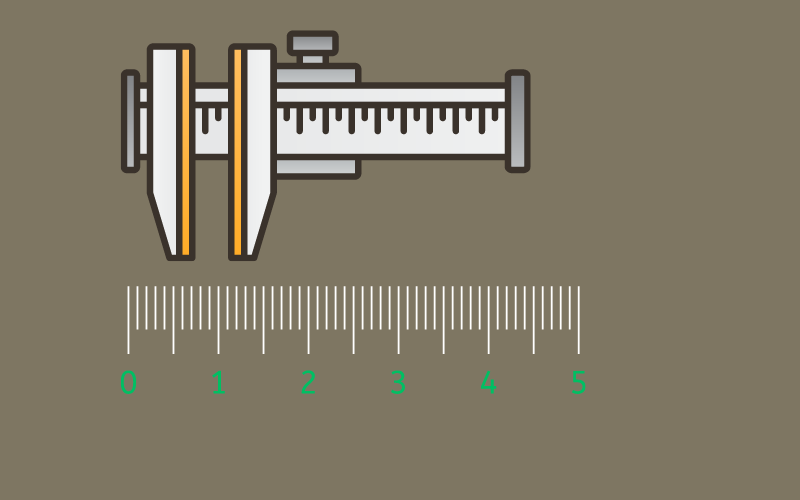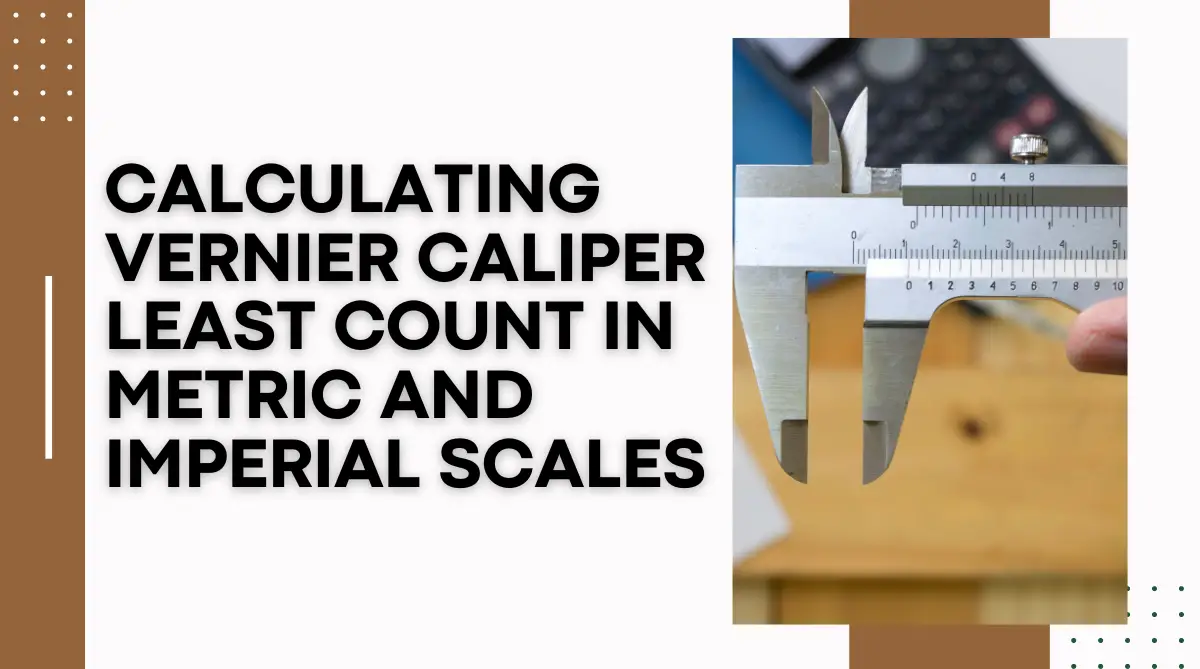Welcome to the realm of precision measurement, where the tiniest details make the biggest impact! Ever wondered how those Vernier calipers work their magic in giving us accurate measurements? Well, hold on tight as we delve into the heart of it – the least count.
Have you ever questioned what “least count” really means in the world of measurements? Imagine it as the superhero of accuracy, the caped crusader ensuring your measurements are as spot-on as a bullseye in archery. It’s the smallest measurement our trusty Vernier calipers can pull off.
The Scale: Foundation of Measurement
Let’s talk scales, not the musical kind, but the ones that lay the foundation for our measurements. Picture a measuring instrument without a scale – it’s like a compass without a needle, a ship without a sail. The scale is the unsung hero in the world of precision.
Have you ever wondered why there are so many divisions on a scale? Think of it as a treasure map with more marks leading you to the hidden chest. The more divisions, the more accurate your measurement – like having more dots on a connect-the-dots puzzle for a clearer picture.
Least Count Determination
Alright, buckle up! We’re about to demystify the art of determining the least count of a Vernier caliper. Imagine it as a secret code – crack it, and you’re on your way to measurement nirvana.
Step-by-Step Calculation of Least Count:
- Main Scale Least Count: Think of this as the backbone, the spine of your precision journey. It’s the smallest measurement the main scale can make.
- Vernier Scale Divisions: Picture the Vernier scale as your trusty sidekick, ready to assist. Count those divisions – they’re the accomplices in your measurement heist.
- Divide and Conquer: Now, take that main scale least count and divide it by the number of Vernier scale divisions. It’s like splitting the loot after a successful mission.
Importance of Vernier Scale Division Verification:
- Don’t rush this step! Think of it as checking your parachute before a jump. Each division on the Vernier scale is a crucial piece of the puzzle. Miss one, and your precision might take a nosedive.
Metric Vernier Caliper Calculation
Time to dive into the metric side of things! In this world, millimeters rule the roost. It’s like navigating a city where each block is a millimeter – precision at its finest.
Step-by-Step Calculation for Least Count:
- Calibration Units: In the metric universe, we’re dealing with millimeters. One main scale division equals 1 cm, further divided into millimeters.
- Vernier Scale Verification: Count those Vernier scale divisions, ensuring they align with the precision squad.
Vernier Caliper Least Count in Millimeters:
- Conversion magic! Multiply the Vernier caliper least count in centimeters by 10, and voila – you have it in millimeters. It’s like converting dollars to euros for your precision travel abroad.
Vernier Caliper Least Count in Millimeters

Now, let’s put our calculations into real-world terms. Imagine your Vernier caliper is a tour guide in the millimeter wonderland, where every step is a millimeter, and precision is the currency.
Conversion Formula: cm to mm:
- A simple shift! Multiply your Vernier caliper least count in centimeters by 10. It’s like changing your measurement currency from meters to centimeters – the same value, just a different unit.
Example Calculation for Metric Vernier Caliper:
- Picture a main scale with 10 divisions in a centimeter. Your least count? 0.1 cm. Now, with 10 Vernier scale divisions, your Vernier caliper least count becomes 0.01 cm or 0.1 mm – precision at its finest.
Stay tuned as we cross over to the imperial side of Vernier calipers in the next section! Are you feeling the precision vibes yet?
Imperial Vernier Caliper Types
Let’s shake things up a bit! In the imperial world, Vernier calipers come in two types. It’s like choosing between two flavors of ice cream – both delicious, but with subtle differences.
Type 1 Imperial Vernier Calipers:
- Main scale division: 0.1 inches.
- Vernier scale divisions: 40 pieces of the precision puzzle.
- Least count calculation: 0.1 divided by 40 equals 0.0025 inches. Precision is in the details!
Type 2 Imperial Vernier Calipers:
- If 40 divisions aren’t your jam, here’s an alternative with 25 divisions on the Vernier scale.
- Smallest measurement from the main scale: 0.025 inches.
- Least count calculation: 0.025 divided by 25 equals 0.001 inch – precision with a different twist.
Type 2 Imperial Vernier Caliper Calculation
Alright, let’s spice things up in the imperial realm with Type 2 Vernier Calipers. It’s like choosing between different car models – they get you to the same destination, but the journey might feel a bit different.
Type 2 Imperial Vernier Calipers:
- If you’re not a fan of 40 divisions, here’s the rebel with 25 divisions on the Vernier scale.
- Picture the main scale division as the highway – 0.025 inches is the smallest measurement you can hit.
- Least count calculation: It’s like divvying up a pie – 0.025 divided by 25 gives you 0.001 inch. Precision, just with a twist!
Ever thought precision could come with different flavors? Stay with us as we unfold the imperial tale of Vernier calipers in the next section!
Precision and Accuracy Relationship
Now, let’s talk about the love story of precision and accuracy. It’s like a dance – precision leading, accuracy following, creating the perfect measurement waltz.
Understanding the Impact of Least Count on Accuracy:
- Least count is the maestro orchestrating the precision symphony. The smaller the least count, the more precise our measurements become.
- It’s not just about being close; it’s about hitting the bullseye every time. Imagine shooting arrows at a target – precision ensures they land in the same spot every shot.
Vernier Caliper Accuracy: A Measure of Least Count:
- If your Vernier caliper boasts a least count of 0.01 cm, it’s not just a number – it’s the margin of error. The smaller the least count, the more accurate your measurements are. It’s like having a GPS that gets you right to your destination, no detours.
Precision and accuracy – they’re the dynamic duo ensuring your measurements are not just good but spot-on. Stay tuned for the metric vs. imperial face-off in the next section!
Metric vs. Imperial Vernier Calipers

Time for the ultimate showdown – metric vs. imperial Vernier calipers. It’s like a battle of two heavyweight champions, each with its unique style and flair.
Contrasting Calibration Units:
- In the metric corner, it’s millimeters ruling the ring – precise and organized, like a well-choreographed dance.
- The imperial contender, on the other hand, deals in inches – a bit more freedom, like a jazz improvisation on the measurement stage.
Implications on Least Count and Precision:
- Metric Vernier calipers, with their millimeter divisions, bring a certain finesse to the game. It’s like using a fine-tip pen for intricate drawings.
- Imperial Vernier calipers, with their inch divisions, offer a different vibe – a broader stroke, like using a paintbrush for bold strokes.
Ever thought precision could have a style preference? Stick around as we explore a practical case study in the next section! Are you ready for the measurement showdown?
Practical Application: Case Study
Let’s dive into the real-world application of Vernier caliper precision with a case study. Imagine you’re an engineer gearing up for a project. You grab your Vernier caliper – it’s not just a tool; it’s your sidekick in the precision battlefield.
Real-World Scenario Demonstrating Least Count:
- Picture measuring the diameter of a critical component. Every fraction matters. Your Vernier caliper, armed with its least count, becomes the hero ensuring that each measurement is spot-on.
Importance of Accurate Vernier Caliper Measurements:
- In the world of engineering, precision isn’t a luxury; it’s a necessity. A miscalculation in measurements could lead to design flaws or, worse, project setbacks. Your Vernier caliper’s least count is your shield against such mishaps.
FAQs – Metric Vernier Caliper
What is the significance of millimeter divisions in metric scales?
- Millimeter divisions bring granularity to metric measurements. It’s like having a high-definition view instead of a pixelated image – clarity at its finest.
How does the least count affect the accuracy of metric measurements?
- The least count is the compass guiding you through the metric landscape. The smaller it is, the more accurately you navigate, ensuring you don’t stray from the precision path.
FAQs – Imperial Vernier Calipers
Why are there different types of imperial Vernier calipers?
- It’s like having different tools in your toolkit. Each type caters to different needs – more divisions or less, depending on the precision dance you’re orchestrating.
How does the main scale division impact the least count in imperial scales?
- The main scale division is the heartbeat of your imperial Vernier caliper. It sets the rhythm, and the least count follows its lead. A larger main scale division might mean a different dance, a different beat.
Tips for Accurate Vernier Caliper Measurements
Alright, precision seeker, we’re almost at the finish line! Here are some golden nuggets of wisdom to ensure your Vernier caliper measurements hit the bullseye every time.
Ensuring Proper Calibration:
- It’s like tuning your guitar before a performance. Regular calibration ensures your Vernier caliper is ready for the precision concert.
Avoiding Common Measurement Errors:
- Picture a tightrope walker avoiding wobbles. Ensure your measurements are steady – no sudden movements or slips.
Ever felt the thrill of a perfectly measured length or diameter? These tips are your backstage pass to achieving that precision nirvana. Now, let’s wrap it up in style!
Conclusion
Whew, what a journey it’s been! We’ve unraveled the mysteries of Vernier calipers, danced with precision and accuracy, delved into metrics and imperials, and even tackled burning FAQs. Your Vernier caliper is not just a tool; it’s a precision companion on your measurement odyssey.
Recap of Key Points:
- Least count is your measurement superhero, determining precision.
- Metrics and imperials offer different flavors of precision – both delicious.
- Vernier calipers, when wielded with accuracy, ensure project success in the engineering realm.
Remember, precision isn’t just a number on a Vernier caliper; it’s the heartbeat of every measurement. Keep it precise, keep it accurate, and let your Vernier caliper be your guide in the precision symphony.
Now, go forth and measure with confidence! Whether you’re an engineer, a student, or a DIY enthusiast, armed with your Vernier caliper knowledge, you’re ready to conquer the world of precision measurement. Until next time, measure on!


